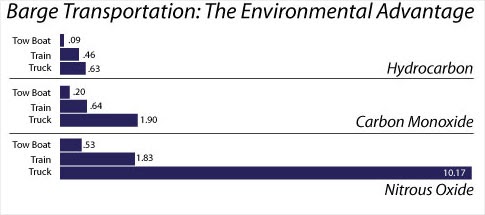Barge Transportation Provides Significant Advantages
Barge transportation and the U.S. inland waterway system are vital to the national economy and the quality of life of U.S. citizens. One of the busiest domestic transportation systems, the U.S. inland waterway system links our heartland to the world.
Over $158 billion worth of cargo is moved annually on U.S. inland waterways like the Port of Victoria, facilitating transportation of one third of the nation’s gross domestic product.
A recent study by the National Waterways Foundation found numerous advantages to the transporting of bulk commodities via inland barge pertaining to cost-effectiveness, environmental factors, traffic congestion and safety considerations that sets it apart from transportation by rail or truck.
Environmental, Efficiency and Safety Advantages
U.S. inland barge transportation has been proven to be the most energy-efficient and environmentally friendly method of moving bulk raw material compared with rail and trucks. Notable advantages to shipping via barge include:
 Better fuel efficiency!
Better fuel efficiency!
Barge = 675 ton-miles traveled per gallon of fuel
Rail = 72
Truck = 151
Lower greenhouse gas emissions!
Barge = 15.1 tons carbon dioxide released per million ton-miles
Rail = 21.6 tons
Truck = 40.7 tons
 Fewer spills!
Fewer spills!
Barge = 2.3 gallons per million ton-miles
Rail = 6.6 tons
Truck = 5.5 tons
Greater capacity!
One common barge tow carries an equivalent load of over 200 rail cars and six locomotives or nearly 1,100 large semi tractor-trailers.
Current waterways freight traffic is equivalent to over 43 million annual truck trips on U.S. roadways.
Safer highways for all!
For every one barge injury, there are 96 rail injuries and a staggering 1,145 with tractor-trailer trucks.
Diverting barge shipments to trucks would add 867 trucks to the current 960 trucks (an increase of 1115) per day, per lane on a typical rural interstate.
“Barge transportation is simply the safest, most energy efficient, and environmentally sound way to move cargo. Barges take pressure off our highway and rail infrastructure, enhance our economy, and lead America to a stronger future.” – Matt Woodruff, Chairman, National Waterways Foundation

